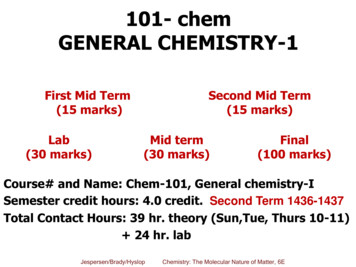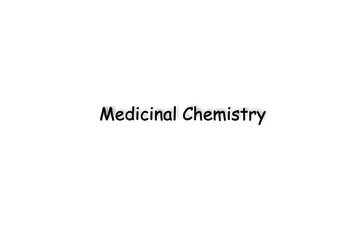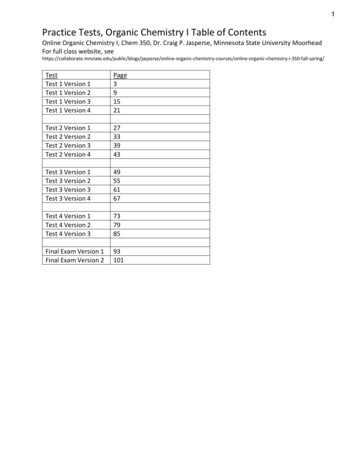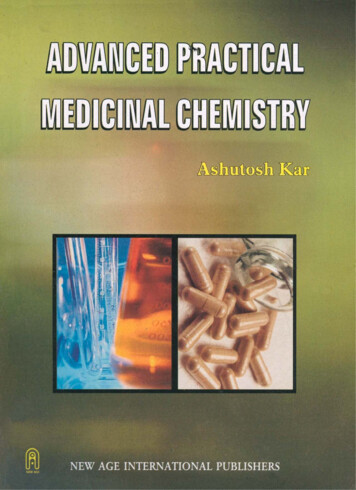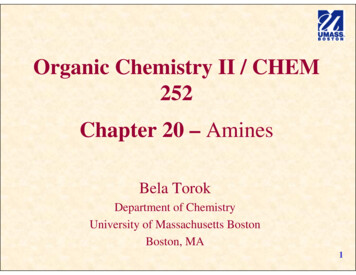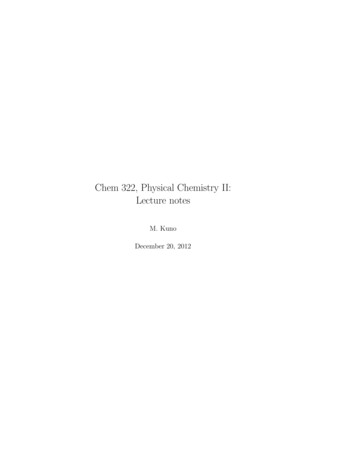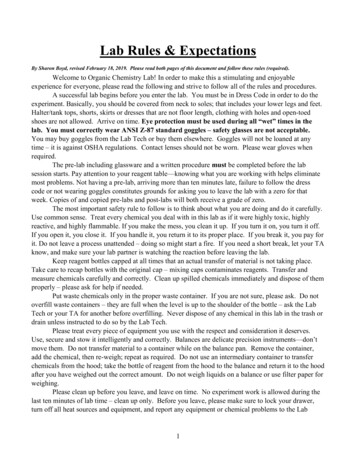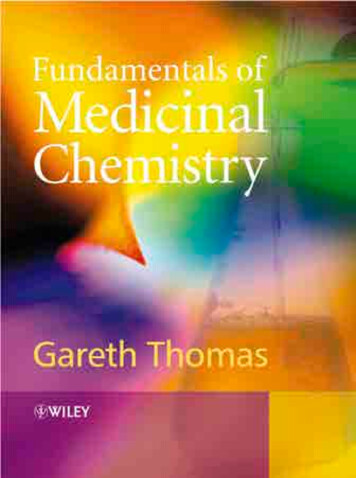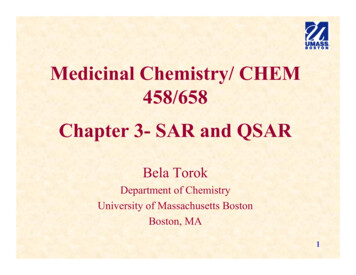
Transcription
Medicinal Chemistry/ CHEM458/658Chapter 3- SAR and QSARBela TorokDepartment of ChemistryUniversity of Massachusetts BostonBoston, MA1
Introduction Structure-Activity Relationship (SAR)- similar structures –similar effects- more potency or improved side effects Quantitative Structure-Activity Relationship (QSAR)- similar structures –similar effects but uses parameters todescribe the potency- parameters – anything (related to drug action) that can berepresented by a numerical values2
Structure-Activity Relationship (SAR) Usually go through minor changes on the lead structure- the and shape of the carbon skeleton- the nature and degree of substitution- stereochemistry3
Structure-Activity Relationship (SAR) Changing size and shape- number of methylene groups in chains and rings- increasing or decreasing the degree of unsaturation- introducing or removing a ring system4
Structure-Activity Relationship (SAR) Changing the number of methylene groups- increases lipophilicity (increased activity)- decreases water solubility (decreased activity)- aliphatic compounds – micelle formation – no selective bindingantipsychoticantidepressant5
Structure-Activity Relationship (SAR) Changing the degree of unsaturation- increasing – rigidity- E-Z isomers might complicate the picture- more sensitivity- increased toxicity1:30antipsychoticantidepressant6
Structure-Activity Relationship (SAR) Introduction or removal of a ring system- addition – size increase, shape changes (effect mostlyunpredictable- increasing size – better fills the hydrophobic pocket- small ring to substitute C C double bonds - stabilityantidepressant7
Structure-Activity Relationship (SAR) Introduction of an aromatic ring- increases rigidity, shape changes resistance toward metabolismmight improve8
Structure-Activity Relationship (SAR) Modifying the ring system of drugs of natural origin- fine tuning of effect and side effectsmore potent(highly addictive)less potent(less addictive)less potentequally potent(less addictive)9
Structure-Activity Relationship (SAR) Introduction of new substituentsmethyl groupsincreases olueneacetamideCH3 CONH 283ureaNH2 CONH 215propionamideN-methylureaStructureP490CH3 CH 2 CONH 2360CH 3NHCONH 244steric hindrance – might block activity013.710
Structure-Activity Relationship (SAR) Introduction of methyl group- methyl group on aromatic rings – increased rate of metabolism- demethylation – easy on heteroatoms, especially on N , S - reduce the rate of metabolism- reduce unwanted side effects11
Structure-Activity Relationship (SAR) Introduction of halogensMostly F and Cl - C-X bond stability - reactivityOH3CCF3 is also very popularCF3OOHOFONHCH3Olocation12
Structure-Activity Relationship (SAR) Introduction of hydroxyl groupsMostly to increase hydrophilic characterPhenolic OH is special13
Structure-Activity Relationship (SAR) Introduction of basic groupsMostly to increase binding via H-bonding/acid baseinteractions14
Structure-Activity Relationship (SAR) Introduction of COOH and SO3H groupsMostly to increase binding via H-bonding/acid baseinteractions – in vivo salt formationintroduction to small leads – usually changes the activitySO3H – no significant effect except faster excretionOther S groups are rare - metabolism15
Structure-Activity Relationship (SAR) Changes the existing substituents of a leadisosteres - bioisosteres16
Structure-Activity Relationship (SAR) Changes the existing substituents of a leadisosteres - bioisosteres17
Structure-Activity Relationship (SAR) Case Study: SAR investigation to discover potent geminalbisphosphonatesfirst generationsecond generation18
Structure-Activity Relationship (SAR) Case Study: SAR investigation to discover potent geminalbisphosphonates19
Structure-Activity Relationship (SAR) Case Study: SAR investigation to discover potent geminalbisphosphonates20
Structure-Activity Relationship (SAR) Case Study:SAR investigationto discover potent geminalbisphosphonates21
Structure-Activity Relationship (SAR) Case Study: SAR investigation to discover potent geminalbisphosphonates22
Quantitative Structure-Activity Relationship(QSAR) QSAR – mathematical relationship (equations)biological effect vs. physicochemical parameters- lipophilicity- electron distribution- shape- size- partition coefficients- Hammett or Tafts constantsBiological activity F {parameters (s)}23
Quantitative Structure-Activity Relationship(QSAR) Regression Analysis24
Quantitative Structure-Activity Relationship(QSAR) Lipophilic parametersPartition coefficientlog (1/C) k1 log P k2(1) Toxicity of alcohols to red spiders:log (1/C) 0.69 log P 0.16r 0.979, n 14, s 0.087(2) The binding of misc. neutral molecules to bovine serum:log (1/C) 0.75 log P 2.30r 0.96, n 42, s 0.159(3) The binding of misc. neutral molecules to haemoglobin:log (1/C) 0.71 log P 1.51r 0.95, n 17, s 0.16(4) Inhibition of phenols on the conversion of P-450 to P-420 cytochromes:log (1/C) 0.57 log P 036r 0.979, n 13, s 0.13225
Quantitative Structure-Activity Relationship(QSAR) Lipophilic parametersPartition coefficient – often paraboliclog (1/C) -k1 (log P)2 k2log P k326
Quantitative Structure-Activity Relationship(QSAR) Lipophilic parametershypnosis (mice) with barbiturateslog (1/C) - 0.44 (log P)2 1.58 log P 1.93 (r 0.969)Hansch – logP 2 hypnotic (CNS drug)27
Quantitative Structure-Activity Relationship(QSAR) Lipophilic parameterslipophilic substituent constants (π) (or hydrophobic)contribution of substituents to Pπ logPX – logPHπ logP(C6H5Cl) – logP(C6H6) 2.84 – 2.13 0.71π π (substituent 1) π (substituent 2) . π (substituent n)28
Quantitative Structure-Activity Relationship(QSAR) Lipophilic parameterslipophilic substituent constants (π)Substituent X-H- CH 3-F- Cl- OH- NH 2- NO 2- OCH3XAliphatic systems R-X0.000.50- 0.170.39- 1.160.470.000.560.140.71- 0.67- 1.23- 0.28- 0.02O2 NXHO0.000.520.540.11- 0.46- 0.390.18X0.000.490.310.93- 0.87- 1.630.50- 0.12log (1/C) vs π high r and low s – important contributor29
Quantitative Structure-Activity Relationship(QSAR) Lipophilic parametersdistribution coefficients (D)ionizationD [ HAorganic ][ H aqueous ] [ A-aqueous ]for acidslog (P/D-1) pH -pK afor baseslog (P/D-1) pK a - pH30
Quantitative Structure-Activity Relationship(QSAR) Electronic parametersThe Hammett constant (σ)σx log K xKσ x log K x - log Kσ x pK - pK x31
Quantitative Structure-Activity Relationship(QSAR) Electronic parametersThe Hammett constant (σ)log (1/C) 2.282 σ - 0.34832
Quantitative Structure-Activity Relationship(QSAR) Steric parametersThe Taft steric parameter (Es)k (XCH2COOCH3)Es logk (CH3COOCH3) k (XCH2COOCH3) - k (CH3COOCH3)log BR 0.440Es - 2.204 (n 30; s 0.37; r 0.886)33
Quantitative Structure-Activity Relationship(QSAR) Steric parametersMolar refractivity (MR)MR (n2 - 1) M(n2 2) ρadditive – functional groups34
Quantitative Structure-Activity Relationship(QSAR) Hansch analysisdrug activity vs. measurable chemical propertiesmultiparameter approachtwo stages: - transport to the site of action- binding to the target sitelog 1/C k 1 (partition parameter) k 2(electronic parameter) k 3 (steric parameter) k 4log 1/C k 1 P - k 2P2 k 3σ k 4 Es k 5
Quantitative Structure-Activity Relationship(QSAR) Hansch analysisAccuracy :- Greater number of analogs – n 5x (x number of parameters)- biological data- the choice of parametersUse:- Asses the factors controlling the activity- predict optimum activity (ideal parameter values)Sources of parameters- CRC, CAS, Merck Index, etc.
Quantitative Structure-Activity Relationship(QSAR) Craig plotsUse with Hansch analysis:log 1/C 2.67π – 2.56σ 3.92
Medicinal Chemistry/ CHEM 458/658 Chapter 3- SAR and QSAR Bela Torok Department of Chemistry University of Massachusetts Boston Boston, MA 1. Introduction Structure-Activity Relationship (SAR) - similar structures –
